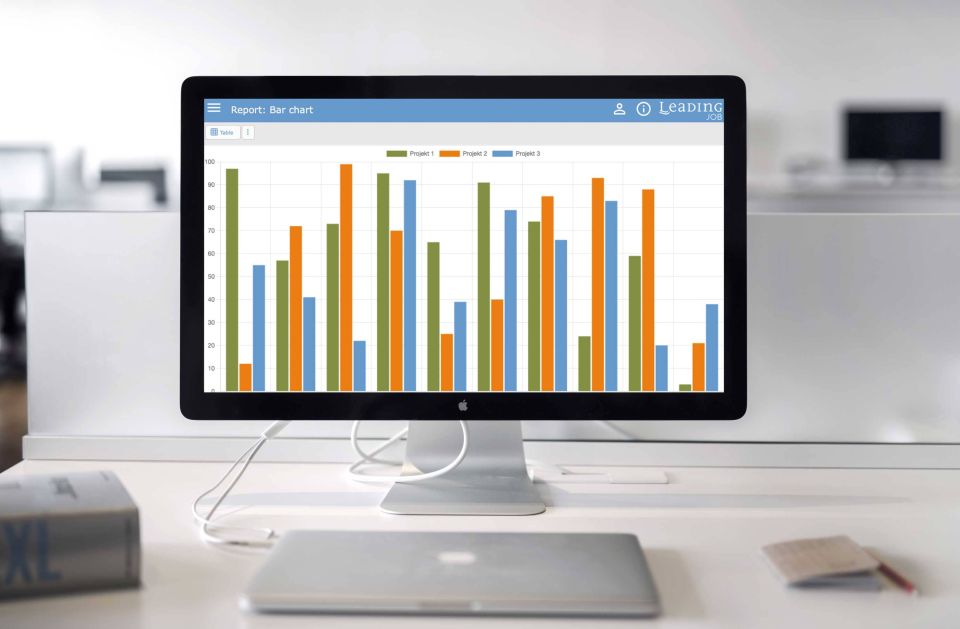The 7 Most Important KPIs for Agencies in Project Controlling
Project controlling is an essential part of project management and helps advertising agencies to manage projects efficiently and purposefully. But what exactly is project controlling and who is responsible for it? In this comprehensive guide, you will learn everything you need to know about project controlling key figures in advertising agencies, the tasks of project controlling and how LEADING Job can help you to manage your projects successfully.

Table of Contents
Who Is Responsible for Project Controlling?
The Role of Project Controlling in Advertising Agencies
Important Project Controlling Metrics for Advertising Agencies
Schedule Performance Index (SPI)
LEADING Job: Your Tool for Effective Project Controlling and Accurate Metrics
The Mother of All Project Metrics: Performance Statistics Report
Other Important Project Controlling Metrics in LEADING Job
What is Project Controlling?
Project controlling encompasses all measures for monitoring and controlling projects. It is an essential part of project management in agencies and ensures that projects remain within the specified goals, budgets and schedules. A distinction is made between operational and strategic project controlling.
Operational project controlling is concerned with the ongoing monitoring and control of projects. The focus here is on short-term project execution and ensuring that the planned measures are carried out within the intended framework.
In contrast, strategic project controlling looks at the long-term goals and framework conditions of the project. It supports the strategic orientation and helps to align the project goals with the overarching corporate goals.
Who is responsible for Project Controlling?
In advertising agencies, the project manager or project leader is usually responsible for project controlling. They are supported by a project controller who takes on specific tasks in the area of controlling.
The Role of Project Controlling in Advertising Agencies
The project controller plays a central role in budget planning and budget control by supporting the preparation of project budgets and monitoring the efficient utilisation of resources and keeping to the budget throughout the duration of the project. He continuously analyses the cost development of the project and reviews expenses for employees, external services, materials and other cost items.
In addition, the project controller is responsible for preparing regular reports that make the current project status, financial performance and other relevant key figures transparent. These reports are used for decision-making at management level. It is also responsible for risk management: it identifies potential risks to project implementation and supports the development of measures to minimise risks.
He is also responsible for using specialised project controlling tools to collect and analyse data and create precise reports. In addition, he monitors compliance with quality standards and client satisfaction by evaluating client feedback, conducting qualitative analyses and organising project reviews. Working closely with the project team and management, the project controller plays a key role in ensuring economic efficiency, adherence to schedules and budgets and the quality of work in the advertising agency and in achieving strategic goals.
All these project controlling tasks are facilitated and automated by using suitable agency software.
Important Project Controlling Metrics for Advertising Agencies
Key performance indicators in project controlling are indispensable tools for evaluating project progress and identifying deviations. Here are some of the most important KPIs that are particularly relevant for advertising agencies:
1 Billable Hours:
The number of hours that can be directly allocated and billed to a client project. For example, a graphic designer works 40 hours a week. 30 of these hours are earmarked for customer projects and can be invoiced, while the remaining 10 hours are used for internal tasks such as training or team meetings.
2 Project Margin
The profit of a project after deducting all direct costs. For example, an advertising agency receives 50,000 euros for a campaign. The direct costs for employees, materials and external services amount to 30,000 euros. The project profitability is therefore 20,000 euros.
3 Resource Utilisation Rate
The percentage of working time that is utilised productively and billable. Let's assume a copywriter is available for 40 hours in a week. Of these, 32 hours are billable (80 %), the rest is earmarked for internal tasks. The resource utilisation rate is therefore 80 %.
4 Estimate Accuracy (EA)
This key figure measures the accuracy of the original time and resource estimates compared to the actual time and resources required. For example, the cost estimate might state a time of 8 hours, but the expected time is 16 hours and it eventually turns out that 17 hours were needed.
5 Cost Performance Index (CPI)
A key figure that measures the ratio of planned costs to actual costs. In a project with a budget of 10,000 euros, 6,000 euros have been spent so far, while the planned progress is 8,000 euros. The CPI is then 1.33 (8,000 / 6,000), which means that the project is more cost-effective than planned.
6 Schedule Performance Index (SPI)
A key figure that measures the ratio of planned progress to actual progress. A project should be 50% complete according to plan, but is actually only 40% complete. The SPI is 0.8 (40% / 50%), which means that the project is behind schedule.
7 Customer Lifetime Value (CLV)
Customer Lifetime Value (CLV) is an estimate of the total revenue generated by a client throughout their relationship with the agency. For example, an advertising agency has a client who purchases 10,000 euros in services annually. The average business relationship lasts five years. The CLV is therefore EUR 50,000 (EUR 10,000 x 5 years). In advertising agencies that maintain long-term customer relationships, the CLV is less relevant as an analysis tool.
LEADING Job: Your Tool for Effective Project Controlling and Precise KPIs
LEADING Job has many practical widgets and reports that contain essential key figures for project controlling in advertising agencies and with which you can always keep the projects in your agency under control:

The Mother of All Project Metrics: Job Survey Report
- One particularly valuable resource is the "Job survey" report, which records several key performance indicators. This report analyses the distribution of working hours across individual projects, which can be used to monitor resource utilisation.
- In addition, the job survey enables the financial performance of projects to be analysed by comparing planned and actual costs, which facilitates the calculation of the Cost Performance Index and helps to stay within budget.
- Similarly, the time-related performance of projects is monitored by comparing planned and actual timesheets, which supports the calculation of the Scheduled Performance Index.
- In addition, the report provides an overview of total revenue across all years, which enables the calculation of Customer Lifetime Value and identifies and promotes valuable long-term customer relationships.
Other Important Project Controlling Metrics in LEADING Job
The billable hours are another key figure that is displayed in LEADING Job using the "Timesheet Report Job PM" and "Hours per Client/Product" reports. This allows project managers to track and calculate in detail how many hours have been worked on each project. This data can also be viewed live in the job management system so that up-to-date information is available at all times.
Another important aspect is the project margin. The "Cost Estimate Statistics" report provides an overview of the number and status of cost estimates created, helping to monitor and manage project margins. This information is also visible live in the job administration.
The accuracy of estimates is a key performance indicator in LEADING Job, which is available live in the job positions. It includes budgeted hours, hours sold and actual hours worked from the timesheet. These analyses can be broken down by activities, teams or individual employees. For example, it can be seen that estimates are often inaccurate for layout creation, whereas they are very precise for copywriting. With this information, agencies can optimise their calculations for future projects and make quotations more precise.

Benefits of the LEADING Job Metrics Dashboard
The LEADING Job dashboard visualises the most important project KPIs, providing a quick overview of the project status. The dashboard helps project managers to make informed decisions and react to deviations at an early stage.
The "Project Report" widget provides you with a practical tool for liquidity management. Here you can see at a glance how much money a project is bringing in, how much costs have already been incurred and how high the turnover is.
When it comes to resource utilisation, the "Employee workload" widget is just the thing. Here you can see how busy your employees are and can easily take countermeasures.
A key element in project controlling is the Scheduled Performance Index (SPI), which project managers can find in the "Project status" widget in the LEADING Job software. This widget shows the current progress of a project in real time. For example, the SPI shows when a project with 10 milestones and 10 hours per milestone has already taken 80 hours after completing 6 milestones instead of the planned 60 hours. This early warning enables project managers to intervene in good time to get the project back on track. LEADING Job thus supports efficient and proactive project management.
